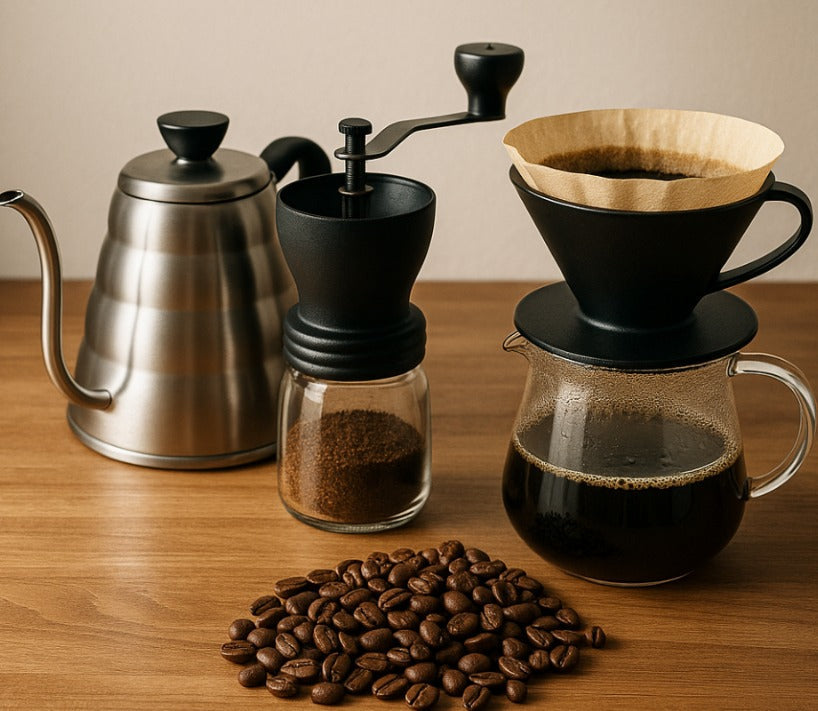New Tariffs, New Troubles: Navigating the Best Top Specialty Coffee Price Conundrum
April 09, 2025 9 min read
New Tariffs, New Troubles: Navigating the Coffee Price Conundrum
Have you ever found yourself scrolling through the news at 6 AM, bleary-eyed and fumbling for your morning caffeine fix, only to stumble across a headline blaring, “New Tariffs on Coffee!”? Cue the dramatic music. My first thought? Great, just when I thought the price of my beloved java couldn’t get any higher. Because, let’s face it, coffee prices have already been marching skyward like a caffeine-fueled parade. Now, on top of all the climate and harvesting issues affecting the world’s most popular beverage, we might face tariffs that give our wallets a little more whiplash.
Before you panic and start hoarding beans like a coffee Doomsday prepper, let’s talk this through. This blog is your backstage pass to understanding how these new tariffs could affect your daily brew (and your budget). While I don’t have a crystal ball to predict the future, I do have enough coffee knowledge to fill a 32-ounce cold brew. So, buckle up and let’s break it all down: what’s going on, why prices are already high, what these tariffs mean, and how I’m personally handling it in my own little corner of the coffee universe.
1. The Climate and Harvesting Rollercoaster
Let’s start with a dash of reality: coffee prices were climbing long before anyone breathed the word “tariff.” Brazil and Vietnam, two coffee giants responsible for a huge chunk of global coffee production, have had a rough couple of years. Brazil has faced erratic weather that’s about as predictable as a cat on catnip. One moment, they’re dealing with drought conditions severe enough to reduce water reserves and stress the coffee plants. The next moment, unexpected frosts are rolling in—yes, frosts in Brazil—damaging crops that simply aren’t built to handle that level of chill.
Vietnam, another powerhouse in the coffee world, hasn’t had it much easier. Shifting weather patterns, unusual rainfall, and intermittent pests have added more obstacles to the coffee production process. So, when yields drop or become inconsistent, the price of coffee beans on the global market naturally goes up. It’s a classic supply-and-demand scenario: if there’s less coffee to go around, that coffee (unfortunately) starts wearing a bigger price tag.
Now, consider that many of us are on the hunt for the best coffee to buy online, especially those single-origin or boutique beans that might brand themselves as the best small batch coffee. If the raw ingredients are harder to come by, it impacts whether you can find the best coffee on the internet at a price that doesn’t make you gasp. The truth is, whether you typically look up “specialty coffee near me” or prefer to order coffee online, you’re already feeling the pinch in your wallet.
2. A Quick Look at Tariffs
So, what exactly is a tariff? In the simplest terms, a tariff is a tax imposed by one country on the goods and services imported from another. Picture a toll booth between two countries—except the fees vary based on political negotiations, trade agreements, or sometimes, heated disagreements. When coffee beans cross borders, tariffs can add to the cost, and eventually, that cost can land on the consumer.
If you’re someone who loves the best craft coffee at home, you might not pay attention to all the intricacies of global trade deals. Let’s be honest—most of us just want a tasty cup of joe at 7 AM that won’t break the bank. But tariffs can, and often do, raise the overall price of goods. That bag of carefully roasted beans, which you once found at a sweet spot for your budget, might suddenly cost a few dollars more.
Now, factor in the current climate issues and the limited supply. Add tariffs to this equation, and you’ve got a recipe for coffee prices that could climb a notch or two—or more. And if you’re looking for the best coffee worldwide or searching for where to buy gourmet coffee, you might find your usual favorites a bit pricier than before. If you’re searching for “where can I buy fresh coffee beans near me,” your local roaster might also have to grapple with higher wholesale costs.
3. Why Coffee Prices Were Already High
I know I’ve mentioned the climate a bunch, but I want to emphasize why coffee was already trading at an unprecedented high even before these tariffs. Let’s zoom out a bit and consider the whole supply chain:
-
Farmers’ Challenges
Farmers in Brazil, Vietnam, and other coffee-growing regions are dealing with unpredictable harvests. That’s everything from fungal diseases, pest infestations, and the all-too-familiar weather extremes. These conditions can slash yields and force farmers to invest heavily in remedies or new farming techniques. -
Global Demand
Coffee consumption isn’t slowing down. In fact, new coffee markets are emerging worldwide as people discover the joys of the best tasting whole bean coffee or realize how satisfying it can be to find a good coffee to drink black that doesn’t taste bitter. As more people step up their coffee game—exploring the best craft coffee online or the best specialty coffee online—the demand side of the equation intensifies. More coffee drinkers + less supply = higher prices. -
Logistics & Shipping
Ah yes, the dreaded shipping bottlenecks. Over the past few years, the cost of moving goods internationally has gone up, whether due to limited container availability, increased fuel costs, or other shipping complexities. This issue applies to coffee as much as it does to electronics, clothes, or those random online impulse purchases we all pretend we didn’t make at midnight.
So, even before tariffs came into play, coffee prices were feeling the heat from these factors. Tariffs are now set to add yet another layer of cost. If you’re looking to buy specialty coffee online, you might see those numbers go up, and it’s not necessarily the fault of your roaster or retailer. It’s a global domino effect.
4. The Tariff Impact
You might be thinking, “Alright, so coffee’s more expensive. But how much are we talking?” The honest answer is, “It depends.” Tariffs can vary in how they’re structured and how long they stay in place. If they linger, roasters and coffee shops might have no choice but to adjust their prices eventually. If the tariffs are brief, you might see only a temporary spike.
As someone who runs a coffee business (and a coffee geek at heart), I’m right there with you, biting my nails over the latest tariff news. I rely on a steady supply of coffee beans from different regions, and I want to maintain fair prices for people who choose to order coffee online. My plan, for now, is to absorb these extra costs personally. It’s not because I have some limitless coffee fortune (believe me, I don’t!). It’s because I have a gut feeling that this tariff situation could be relatively short-term. Maybe I’m overly optimistic—or maybe I just don’t want to see your morning cup of coffee morph into a luxury item.
But here’s the real talk: if these tariffs end up lasting longer than expected, or if other factors like climate change worsen supply issues, I might have to raise prices eventually. I don’t say that lightly. For many of us who treasure our morning brew, the thought of paying a premium for everyday coffee is a bit daunting. Still, at the end of the day, small businesses can only operate at a loss for so long. We want to provide the best coffee worldwide, or at least come close, but we also need to keep the lights on.
5. So, Should You Panic?
Short answer: No, not yet. While the news might make you wonder if you should stockpile beans like you’re bracing for a coffee apocalypse, it’s essential to remember that the tariff talk is still relatively new. One of two things will happen: either the tariffs will stay in place, or they might be lifted or reduced if trade negotiations go in a more positive direction. And if you’re someone who loves exploring the best coffee on the internet, a tariff doesn’t automatically mean your favorite roaster will jack up the price tomorrow morning. Most roasters want to avoid abrupt changes that scare away their loyal customers.
Additionally, if you’re someone who needs to find the best coffee for non coffee drinkers (maybe you have a friend who’s coffee-curious but sensitive to bitterness), or if you’re looking for presents for coffee lovers and hoping to give coffee beans as a gift, you can still do so without emptying your wallet—at least for now. My advice? Don’t let these headlines ruin your coffee experience. Keep enjoying your daily cup while staying informed about what’s happening in the world of coffee production and trade.
By now, you might be wondering, “Okay, so what’s in this for me? Why read this long-winded coffee rant?” Well, let me break down the reward for sticking with me through the nitty-gritty details:
-
A Deeper Appreciation for Your Cup
You know how sometimes you learn the backstory behind a piece of art or a bottle of wine, and it just tastes better? It’s the same with coffee. Understanding the challenges farmers face in Brazil or the changes forced by a new tariff might give you that extra appreciation for the beans in your cup. It’s not just about flavor—it’s about the journey from farm to mug. -
Knowledge to Make Informed Decisions
Whether you prefer the best craft coffee at home, love to buy specialty coffee online, or simply want to find “specialty coffee near me,” being informed about market factors helps you shop smarter. You can compare prices more effectively and understand why certain roasters might charge what they do. And when you stumble across a deal that’s too good to be true, you’ll know enough to ask how that’s even possible given global coffee trends. -
Peace of Mind
There’s a certain relief in realizing that you’re not alone in your coffee cost woes—this is a global issue, influenced by a web of interconnected factors. You also know that at least one roaster (hi, that’s me!) isn’t going to raise prices overnight. That knowledge might let you breathe easier the next time you need to order coffee online or plan a gift for coffee lover friends. If the situation changes drastically, you’ll be prepared rather than blindsided. -
A Sense of Connection
Coffee has this magical ability to bring people together. Whether you’re sipping in a bustling café or brewing at home while chatting on a video call, coffee is a shared ritual. The more you understand about the people behind that ritual—farmers, roasters, importers, exporters, and even the bureaucrats setting tariffs—the more connected you might feel to the larger community. And trust me, coffee lovers are some of the most passionate, friendly folks you’ll meet. -
Empathy for Small Businesses
If you’re ever tempted to grumble about a price hike, it helps to see the bigger picture: many small coffee businesses are taking financial hits right now, hoping that this is a temporary storm. We want to keep offering the best coffee worldwide (or at least strive for that ideal), but sometimes circumstances push our margins to the brink. Understanding those pressures fosters a bit of empathy for those behind the counter or behind the roasting machine.
Putting It All Together
Listen, I’m not here to rain on your caffeine parade—or maybe I am, but only so you have an umbrella handy. Tariffs are just one more element in an already complex coffee equation, an equation that includes climate change, shipping woes, rising demand, and labor challenges. The result? Coffee prices that are as unpredictable as the weather.
But don’t fret too much. If you love to buy specialty coffee online or have a favorite local roaster, keep supporting them in whatever way you can. Ask them questions about roast dates, origins, and how they’re handling these fluctuations. The more transparent your roaster is, the more confident you can feel about paying a fair price for high-quality beans.
As for me, I’ll keep absorbing these extra costs as long as I can. My intuition says this might blow over—but then again, intuition doesn’t always match reality. If the new tariffs become permanent fixtures or if climate setbacks worsen, I’ll have to reconsider my prices to ensure the health of my livelihood. Honesty is the best policy, right? Especially when it’s fueled by a potent cappuccino.
If you’ve hung out with me this long, you’re practically a walking coffee encyclopedia—congratulations! You’ve delved into the complexities of climate conditions in Brazil and Vietnam, you’ve explored the world of tariffs, and you’ve learned why coffee prices often feel like they’re on a never-ending upward trajectory. Most importantly, you’ve discovered that while new tariffs may raise the cost of coffee, they don’t automatically doom us all to a world of astronomically expensive lattes.
Coffee is resilient, and so are the people who grow, roast, and brew it. So the next time you’re weighing whether to order coffee online or type in “where to buy gourmet coffee,” just remember: there’s a whole global story behind that cup. It might cost a bit more in the short term, but you’re also supporting a vast network of farmers, traders, and roasters who pour their hearts into bringing you the best beans possible. You’ve also got one roaster (hint: me) who’s doing his best to keep your costs steady until the storm passes—or until we figure out a new normal.
For now, brew that cup with a bit of gratitude, maybe a dash of optimism, and know that when it comes to coffee, we’re all in this together—tariffs or not. Cheers to staying caffeinated, informed, and maybe even a little hopeful about what tomorrow might bring. After all, we can’t solve every global trade issue overnight, but at least we can face them with a fresh cup in hand.
Also in Best Coffee To Buy Online Education

Freshest Specialty Coffee at Home: Value Over Discounts
November 04, 2025 4 min read
Why many roasters discount beans, why I don’t, and how to build Freshest Specialty Coffee at Home with roast-dated, high-scoring, roast-to-order coffee. Includes a fast plan, a comparison table, and clear buying rules.

Brewing The Best Coffee at Home: Stop Waiting in Line
November 03, 2025 4 min read
Learn Brewing The Best Coffee at Home with a quick Proof → Promise → Plan system: choose fresh, roast-dated beans, use a simple 1:16 recipe at 200°F, and lock a 4–6 minute routine that beats the drive-thru on taste, time, and cost.

Best Tasting Coffee At Home: Stop Buying “Deals,” Start Buying Value
November 02, 2025 4 min read
Want the Best Tasting Coffee At Home? Skip old ‘deal’ beans. Use fresh, high-scoring, air-roasted coffee and a simple 1:16 plan. This guide shows proof, a clear promise, and a step-by-step plan to order smart, brew better, and enjoy sweeter, cleaner cups—daily.
